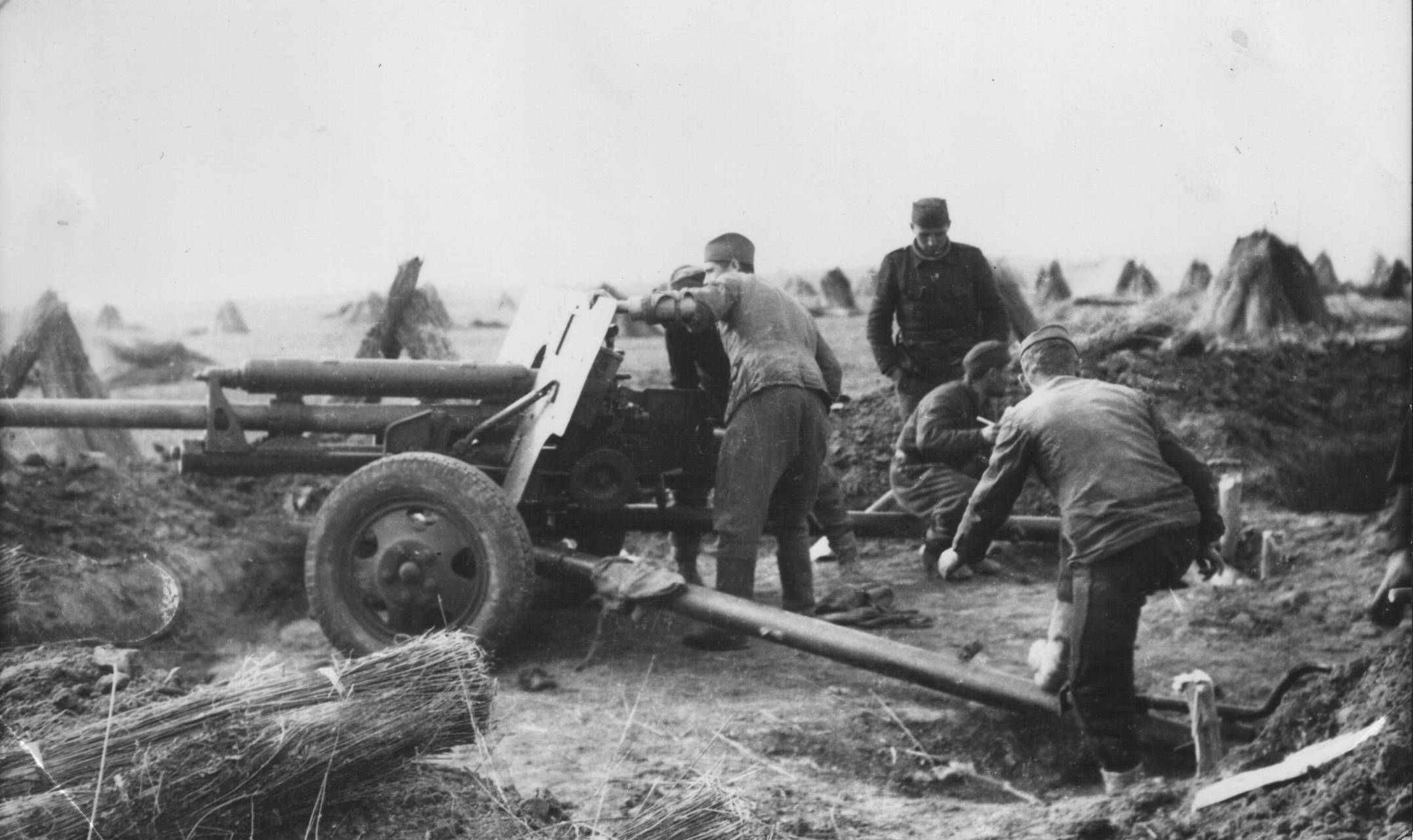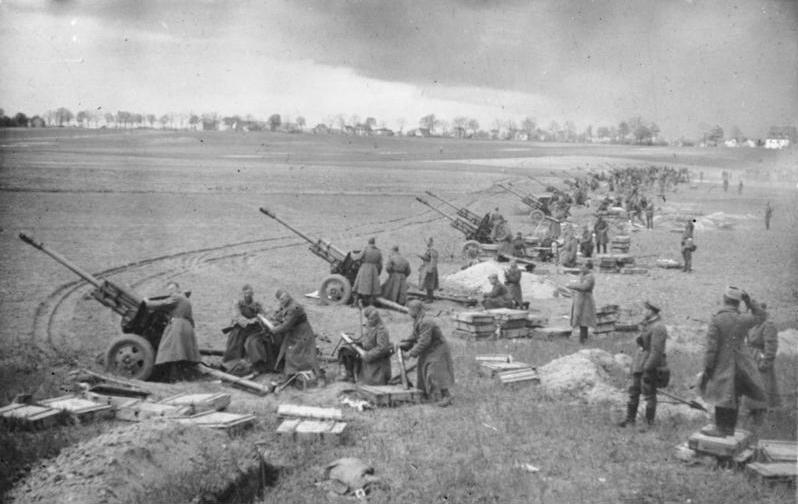The Book of Armaments:
Soviet 76.2mm Guns, Part Three
by Mike Bennighof, Ph.D.
May 2021
 By the spring of 1937, Marshal of the Soviet Union Mikhail Tukhachevsky had lost his bureaucratic power struggle with his boss, Kliment Voroshilov. With his star fading and soon to meet a firing squad, the concept of a universal field cannon also faded. But with nearly 3,000 of the F22 76.2mm gun either built or on order, the advocates of replacing field guns with howitzers failed in their efforts to make the new Model 60 107mm divisional gun the standard weapon of the Red Army’s light artillery battalions. Instead, the F22 would be replaced with a new-model 76.2mm gun, one that could make use of the huge stocks of ammunition held for the F22 and the earlier Model 1902. By the spring of 1937, Marshal of the Soviet Union Mikhail Tukhachevsky had lost his bureaucratic power struggle with his boss, Kliment Voroshilov. With his star fading and soon to meet a firing squad, the concept of a universal field cannon also faded. But with nearly 3,000 of the F22 76.2mm gun either built or on order, the advocates of replacing field guns with howitzers failed in their efforts to make the new Model 60 107mm divisional gun the standard weapon of the Red Army’s light artillery battalions. Instead, the F22 would be replaced with a new-model 76.2mm gun, one that could make use of the huge stocks of ammunition held for the F22 and the earlier Model 1902.
The order for a new design appears to have gone out secretly, as V.G. Grabin, who had designed the F22, only received the specifications some months after other design bureaus had already begun work. Three other entries therefore went to field testing before Grabin’s design, which he labelled the F22-USV even though it was essentially a new design carrying only some features of the F22. The Kirov Plant’s L-12 design initially passed most of its tests, but its semi-automatic locks failed; apparently French-made rounds from the Great War had been issued for the tests, and the aging ammunition, more than two decades old at that point, caused the failures. But that opened the door for Grabin’s new cannon, which passed all of its tests thanks to the use of newly-made rounds.
Production of the Model 1939 began in late 1939 at Plant No. 92 in Gorkiy. The slow pace of construction led to authorization to use the 1,000 carriages already assembled for the ZiS-2 57mm anti-tank gun; the extremely long barrel of the latter weapon proved difficult to manufacture and production of carriages had out-paced that of gun barrels. To relieve the bottleneck, Stalingrad’s Plant No. 221, the famed Red Barricades munitions works (the largest in Europe) took up production as well in 1941, and continued to make the Model 1939 for months after the new ZiS-3 should have replaced it on the production line. Josef Stalin had issued a directive to all artillery plants to maximize production even at the expense of quality, and so shielded by the Great Helmsman’s seal of approval the plant’s management ignored repeated orders to switch models in order to pump out as many weapons as possible as the Germans approached the city. Production only stopped when German infantry physically overran the assembly lines.

Firing the 76.2mm Model 1939.
A simpler carriage helped quicken production; the cannon used the same rubber tires as the ubiquitous ZiS-5 truck and could be pulled by motor vehicles or horse teams. It still carried some elements of the F22 universal cannon; early production models could still elevate to 75 degrees, useful only for anti-aircraft fire; later ones limited this to 45 degrees. The new cannon was substantially lighter than the F22 though still taller than it needed to be. The Model 1939 boasted a greater rate of fire than the Model 1936; range and explosive power were the same, since they fired the same ammunition.
Despite the improvements, the Model 1939 remained a substandard weapon, and on his own initiative Grabin began work on a replacement. The chief of the Artillery Directorate, Marshal G.I. Kulik, had lost the argument with Tukhachevsky over a heavier piece for the divisional artillery, and did not intend to lose again. The new divisional gun should be heavier, with a caliber somewhere in the range of 85mm to 95mm, and a dual-purpose field gun and anti-tank gun to counter the expected next generation of heavy tanks.
With the German invasion, Kulik went to command Western Front and spent the Great Patriotic War bumbling from command to command and somehow avoiding the firing squad until 1950. On their own authority Grabin and his boss, plant manager A. Yelyan, put Grabin’s new-model 76.2mm divisional gun into production at Plant No. 92, using Stalin’s directive as bureaucratic cover.

A Yugoslav crew with their 76.2mm ZiS-3, 1945.
Grabin began work on the ZiS-3, as he called the new gun, in May 1941. The design drew heavily on the 57mm ZiS-2 high-velocity anti-tank gun, using the same carriage (which had also been used for most of Plan No. 92’s production of the Model 1939) and many innovations from the ZiS-2. The 76.2mm version likewise had a long barrel, hydraulic recoil and a muzzle brake.
The cannon, later known as the “crash-boom” to German troops from the sound of it’s supersonic shell quickly followed by the sound of said shell exploding, had already been issued to at least two rifle divisions when it began field testing, which lasted for all of five days. Stalin himself gave the cannon his approval, and it officially entered mass production as the Model 1942 in February, even though hundreds of guns were already in action. Plant No. 92 churned out an astonishing 42,000 copies by the end of the Great Patriotic War, with another 6,300 built at Plant No. 235 in Votinsk at the southern end of the Ural Mountains. In addition to those built as field guns, Plant No. 92 delivered 14,450 guns for use on the SU76 self-propelled mount.
The Model 1942 weighed less than half of the Model 1936’s 2.8 tons, and considerably less than the Model 1939; it was only slightly heavier than the ZiS-2 57mm anti-tank gun and also had a correspondingly lower profile than the earlier field guns. It could be easily maneuvered by its crew, and towed not only by trucks and prime movers but by lightweight scout cars, and by horse teams.
Perhaps most importantly, the Model 1942 was both easy to manufacture and easy to use. Raw labor drawn into the factories could build the gun with little training, and raw recruits could learn to fire it, similarly with little training. It did not require scarce strategic materials in its construction.

Many batteries of 76.2mm ZiS-3 field guns outside Berlin, 1945.
Its weaknesses were those it shared with all the other 76.2mm field guns: the lightweight explosive charge of its relatively small round, and as the war dragged on an inability to knock out the latest German heavy tanks. More Model 1942 guns were produced during the Great Patriotic War than any other Soviet artillery piece, and it remained in use for decades after the war’s end.
The last 76.2mm gun produced for the Red Army was the Model 1943 regimental gun, what the German Army called an infantry gun. The Model 1927, known as “bobby” to the infantrymen, was a popular weapon as it gave the rifle battalions their own direct-fire artillery support. But by 1942 Bobby could no longer knock out German tanks even at point-blank range, and the Artillery Directorate set out requirements for a new regimental cannon.
The project slowed when Grabin’s team presented a design that promptly failed its tests. Their gun was simply a ZiS-3 with a barrel cut to short length, and it produced a prodigious recoil as a result. The Kirov plant offered an upgraded Bobby with a lengthened barrel, which also failed in its tests.
The entire project seemed doomed by the introduction of High-Explosive Anti-Tank (HEAT) rounds, which gave Bobby more acceptable performance against enemy armor. The design of a new regimental cannon passed to the OKB-172 design bureau, an office staffed by prisoners (including the lead engineers) and closely supervised by the NKVD. The chief engineer, Mikhail Tsirulnikov, had been arrested in 1939 and sentenced to eight years in prison.
Tsirulnikov’s design placed a short barrel on the carriage of a 45mm anti-tank gun, which resulted in a small and lightweight cannon that did not meet specifications for muzzle velocity. However, it did have many other modern features, chiefly excellent mobility, and with HEAT ammunition now available and no other regimental cannon projects still active, the Artillery Directorate approved his design for production. Tsirulnikov was released from prison and named a Laureate of the Stalin Prize, and his cannon went into production as the Model 1943.
Over 5,000 of them were produced by war’s end, and assigned to rifle regiments for direct-fire support again enemy machine-gun nests and fortified positions. The troops liked the new weapon even more than they had its Uncle Bobby. It was provided to the North Korean People’s Army for use in the invasion of South Korea, and the Norks despised the weapon for its short range.
You can order The Book of Armaments Vol. One right here.
Please allow an additional three weeks for delivery.
Sign up for our newsletter right here. Your info will never be sold or transferred; we'll just use it to update you on new games and new offers.
Mike Bennighof is president of Avalanche Press and holds a doctorate in history from Emory University. A Fulbright Scholar and NASA Journalist in Space finalist, he has published eleventy-million books, games and articles on historical subjects.
He lives in Birmingham, Alabama with his wife, three children and his dog Leopold.
Want to keep Daily Content free of third-party ads? You can send us some love (and cash) through this link right here.
|
